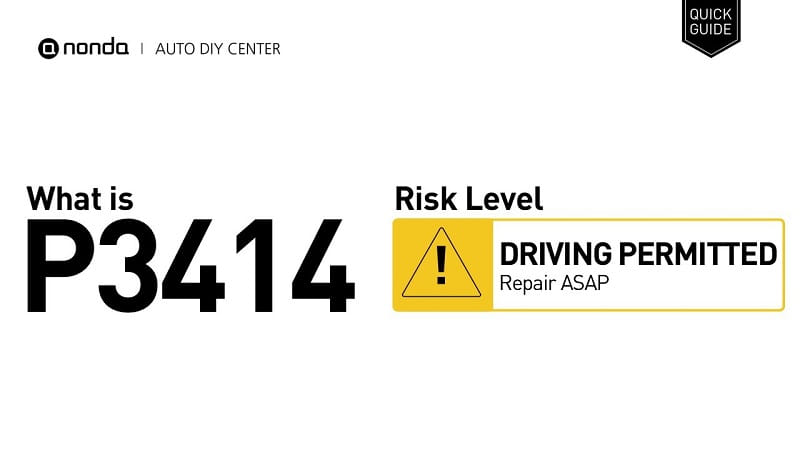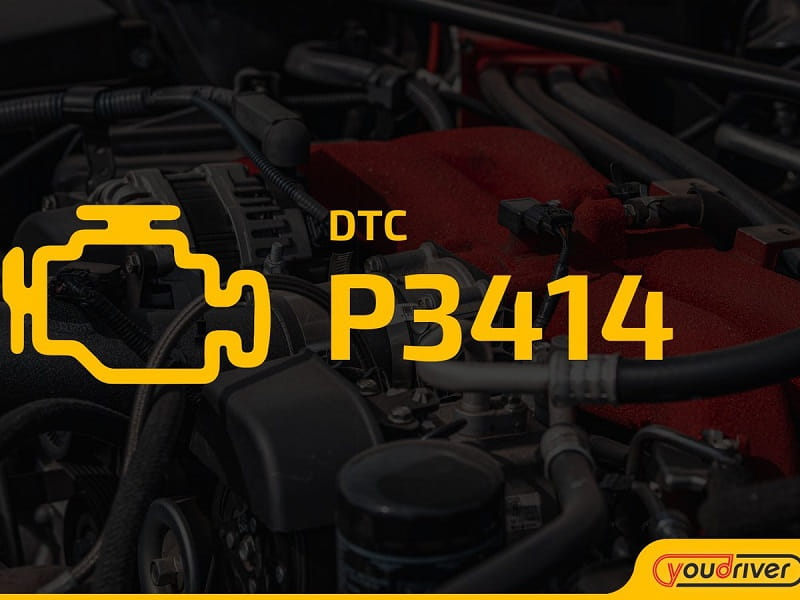This post contains affiliate links. This means I will make a commission at no extra cost to you should you click through and make a purchase [ “As an Amazon Associate, I earn from qualifying purchases.” ]. Read the full disclosure here.
Understanding Diagnostic Trouble Code P3414 Cylinder 2 Exhaust Valve Control Circuit Performance GuideMechanic.Com Modern internal combustion engines are equipped with numerous electronic and mechanical systems that optimize performance, increase fuel economy, and reduce emissions.
Among these innovations, Variable Valve Timing (VVT) and cylinder deactivation systems play a vital role in how efficiently an engine operates under varying load conditions. These systems rely heavily on sensors, solenoids, and electronic control units (ECUs) to function correctly.
When something goes wrong within the exhaust valve control system—particularly for a specific cylinder—the engine’s Powertrain Control Module (PCM) logs a Diagnostic Trouble Code (DTC) to help identify the malfunction. One such code is P3414: Cylinder 2 Exhaust Valve Control Circuit Performance.
This article explores everything you need to know about P3414, including what it means, its symptoms, causes, diagnostic procedures, and effective repair solutions.
See Also: P3415 Cylinder 2 Exhaust Valve Control Circuit Low
P3414 Cylinder 2 Exhaust Valve Control Circuit Performance
What Does Code P3414 Mean?

Diagnostic Trouble Code P3414 refers to a performance issue in the exhaust valve control circuit for cylinder 2. The code is typically set by the PCM when it detects that the exhaust valve actuator for cylinder 2 is not performing as expected—even if it’s receiving the correct signals.
In contrast to codes indicating an open or shorted circuit (like P3413 or P3415), a performance code means the circuit is electrically intact, but the actuator isn’t behaving as expected. This can point to a mechanical problem, hydraulic issue, or a delay in the system’s response.
The exhaust valve control system often uses electrically controlled solenoids and engine oil pressure to activate or deactivate the exhaust valves based on the driving conditions. Proper timing and function are crucial to maintaining engine efficiency and reducing emissions.
P3414 Cylinder 2 Exhaust Valve Control Circuit Performance
Symptoms of Code P3414
The symptoms of P3414 can range from mild to severe, depending on the extent of the malfunction. Common symptoms include:
Illuminated Check Engine Light (CEL)
The most immediate and universal symptom of any DTC.
Rough Idle
The engine may idle poorly due to irregular exhaust flow or valve timing.
Reduced Power Output
The engine may enter a limp mode or experience sluggish acceleration.
Decreased Fuel Efficiency
Improper exhaust valve timing can throw off the engine’s combustion process.
Engine Misfire (especially on Cylinder 2)
Poor valve control can lead to incomplete combustion.
Increased Emissions
Exhaust gases may not be expelled efficiently, increasing pollution.
P3414 Cylinder 2 Exhaust Valve Control Circuit Performance
What Causes P3414?
The P3414 code can be triggered by a variety of electrical, mechanical, and hydraulic problems. The most common causes include:
Faulty Exhaust Valve Control Solenoid (Cylinder 2)
The solenoid may be sticking, delayed, or not actuating fully, even if receiving the correct command.
Contaminated or Low Engine Oil
Dirty or insufficient oil can prevent the solenoid from controlling the valve correctly due to reduced hydraulic pressure.
Oil Control Blockage
Sludge or debris in the oil passages can restrict oil flow, affecting solenoid operation.
Electrical Resistance Issues
Even if the circuit isn’t open, increased resistance due to corroded terminals or aging wires can affect solenoid performance.
PCM Software or Hardware Fault
In rare cases, a problem in the engine control unit itself may cause delayed or improper signals.
Mechanical Issues in the Valve Train
Weak valve springs, worn rocker arms, or broken camshaft lobes can interfere with proper valve timing.
P3414 Cylinder 2 Exhaust Valve Control Circuit Performance
Diagnosing Code P3414

Proper diagnosis is key to addressing the root cause of P3414 without unnecessary part replacements. Here’s a step-by-step guide:
1. Scan for Trouble Codes
Use a professional OBD-II scanner to verify that P3414 is present.
Look for any related codes, such as P3400 (cylinder deactivation system), P0302 (cylinder 2 misfire), or oil pressure-related codes.
2. Visual Inspection
Check for any obvious damage to the wiring harness, connectors, or solenoid body.
Inspect for oil leaks, broken clips, or corroded terminals.
3. Check Oil Level and Condition
Low oil or dirty oil can significantly impair solenoid function.
If the oil is dark, thick, or contains debris, an oil change may be needed before further testing.
4. Test the Solenoid Functionality
Remove the exhaust valve control solenoid for cylinder 2.
Bench test it using a 12V power source to check whether it actuates properly.
If slow or unresponsive, replace it.
5. Measure Circuit Resistance
Use a digital multimeter to measure the resistance across the solenoid.
Compare with factory specifications (usually between 8–15 ohms depending on the manufacturer).
6. Check for Oil Flow Restrictions
If possible, inspect the oil passages for blockages or sludge buildup.
This may require removing the valve cover or oil control housing.
7. Inspect Valve Train Components
If solenoids and oil supply are fine, check the mechanical integrity of the valve train (rockers, lifters, springs, etc.).
P3414 Cylinder 2 Exhaust Valve Control Circuit Performance
How to Fix Code P3414
After identifying the root cause, the proper solution can be implemented. Common repairs include:
Replace Faulty Exhaust Valve Control Solenoid
If the solenoid is sluggish, non-responsive, or fails a bench test, it should be replaced with an OEM or high-quality aftermarket unit.
Perform an Oil Change
If the oil is dirty or incorrect for your engine (wrong viscosity), drain and refill using the manufacturer-recommended oil.
Clean or Repair Oil Passages
Use engine flush products if necessary to remove sludge and restore proper oil flow.
Repair or Replace Wiring
Fix any frayed wires or corroded terminals that might be interfering with proper current flow.
Update or Reflash PCM
If the PCM is operating with outdated firmware or software glitches, reprogramming it at the dealership or with a certified scan tool may solve the issue.
Inspect and Replace Mechanical Components
If wear or damage is found in the valve train (such as a collapsed lifter or broken spring), those parts must be replaced.
P3414 Cylinder 2 Exhaust Valve Control Circuit Performance
Preventive Measures
To avoid future occurrences of P3414 and keep your engine in top shape, consider these best practices:
- Change Oil Regularly: Follow your vehicle’s service schedule to prevent sludge and ensure adequate lubrication.
- Use Correct Oil Type: Always use oil with the correct viscosity and rating specified by the manufacturer.
- Avoid Cheap Oil Filters: Low-quality filters may not properly clean oil, leading to clogged passages.
- Inspect Electrical Connections Periodically: Clean any corrosion or debris from plugs and connectors.
- Address Minor Issues Promptly: A small oil leak or warning sign can escalate if ignored.
- Stay Up to Date with Recalls and TSBs: Check for any technical service bulletins (TSBs) related to valve control systems.
Conclusion
The P3414 – Cylinder 2 Exhaust Valve Control Circuit Performance code is an indicator of a nuanced issue that affects how efficiently your engine can breathe and operate.
Unlike simple electrical faults, performance codes often involve a combination of mechanical, electrical, and hydraulic factors.
Whether it’s a sticking solenoid, contaminated oil, or wiring issues, prompt and precise diagnosis is crucial to restoring your vehicle’s performance. Left unchecked, this issue can lead to engine misfires, reduced fuel economy, increased emissions, and long-term engine damage.
By understanding what P3414 means and how to handle it, both DIY mechanics and professionals can take proactive steps to ensure the engine runs smoothly and efficiently for years to come.
- 4×4 Truck for Sale Used - October 21, 2025
- 4×4 Truck for Sale Under 20K - October 15, 2025
- 4×4 Truck for Sale QLD - October 12, 2025
